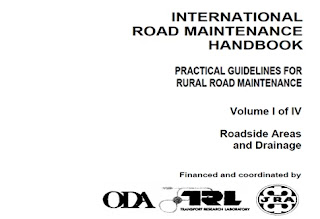International Road Maintenance Handbook 1
 |
| International Road Maintenance Handbook 1 |
| INTERNATIONAL ROAD MAINTENANCE HANDBOOK 1 | |
|---|---|
| Bahasa | : Inggris |
| Halaman | : 331 Halaman |
| Format | |
| Sumber | : - |
| Sifat | : GRATIS |
| Download | |
CUPLIKAN ISI EBOOK
MAINTENANCE OF ROADSIDE AREAS AND DRAINAGE
Contents
Part A - List of Terms
This volume provides a List of Terms used in the Handbook and an Index covering all of the four volumes.
Part B - Works Management and Safety
General guidelines are provided regarding management and safety of the maintenance operations.
This volume also describes the maintenance of roadside areas and drainage. Although generally straightforward these operations are often neglected.
They are, however, important and have the following objectives:
a. To minimise the safety risk to road users due to poor shoulders and slopes, poor visibility, grazing animals or fire hazard etc.
b. To ensure the stability of the road foundations.
c. To ensure that all rain and ground water is directed away from the road, and does not endanger its strength or stability.
Part C - Roadside Areas
Routine and Periodic Maintenance activities are described which keep the roadside areas in their intended and stable condition, and keep vegetation under control. Most of the tasks require labour, although some may be carried out by mechanised methods if the equipment is available.
Part D - Drainage
The drainage system is the most important component of a highway or rural road, even in locations with only occasional rainfall. The Routine Maintenance of the drainage system of ditches, pipe drains, culverts and drifts is essential to preserve the road structure and running surface. Most of the activities can be carried out by labour methods.
COMPONENTS OF THE HIGHWAY
Blinding
a) A layer of lean concrete, usually 5 to 10 cm thick, placed on soil to seal it and provide a clean and level working surface to build the foundations of a wall, or any other structure.
b) An application of fine material e.g. sand, to fill voids in the surface of a pavement or earthworks layer.
Bridge
A structure usually with a span of 5 metres or more, providing a means of crossing above water, a railway or another obstruction, whether natural or artificial. A bridge consists of abutments, deck and sometimes wingwalls and piers.
Camber
The road surface is normally shaped to fall away from the centre line to either side. The camber is necessary to shed rain water and reduce the risk of passing vehicles colliding. The slope of the camber is called the crossfall. On sharp bends the road surface should fall directly from the outside of the bend to the inside.
Carriageway
The road pavement or bridge deck surface on which vehicles travel.
Causeway or Vented Drift
Low level structure constructed across streams or rivers with openings to permit water to pass below road level. The causeway may become submerged in flood conditions.
Coffer Dam
A temporary dam built above the ground to give access to an area which is normally, or has a risk of being, submerged or waterlogged. Cofferdams may be constructed of soil, sandbags or sheetpiles.
Culvert
A structure allowing water to flow under the road and having an open span of normally between 0.5 and about 5 metres. The opening may be round, rectangular or arched. The invert, walls and soffit often form an integral unit.
Parapet
The protective edge, barrier, wall or railing at the edge of a bridge deck.
Pavement
The constructed layers of the road on which the vehicles travel.

Post a Comment for "International Road Maintenance Handbook 1"